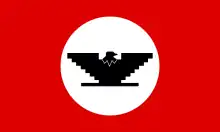Indigenous Mexican Americans
Indigenous Mexican Americans or Mexican American Indians are American citizens who are descended from the indigenous peoples of Mexico. Indigenous Mexican-Americans usually speak an Indigenous language as their first language and may not speak either Spanish or English. Indigenous Mexican-Americans may or may not identify as "Hispanic" or "Latino". While some identify as Mexican and Indigenous, others instead solely identify with their Indigenous nation/community/culture.
| Total population | |
|---|---|
| 1,475,436[1] | |
| Regions with significant populations | |
| California, Texas, New York, Arizona, Colorado, Illinois, New Mexico, Nevada | |
| Languages | |
| American English, Spanish, Mixtecan languages and other Mesoamerican languages | |
| Religion | |
| Christianity, Mesoamerican religion | |
| Related ethnic groups | |
| Native Americans in the United States |
| Part of a series on |
| Chicanos and Mexican Americans |
|---|
 |
|
Demographics
California is home to a large and growing population of Indigenous people of Mexican birth or descent. 200,000 people in the state are descended from one or more of Mexico's over 60 Indigenous groups.[2] Many of these Indigenous Mexican-Americans hail from the indigenous people of Oaxaca, with California being home to between 100,000 and 150,000 indigenous Oaxacans. 50,000 are estimated to be Mixtec, an indigenous people from the La Mixteca region of Western Oaxaca and nearby portions of Puebla and Guerrero.[3]
Discrimination
Most Mexicans who identify as Mestizo, have very large amounts of Indigenous ancestry. Despite this they are culturally assimilated into mestizaje and therefore do not identify culturally or politically Indigenous peoples of Mexico. They are generally not part of an Indigenous community, and do not have the same experiences as people who are culturally and politically Indigenous. There is both cultural mestizaje, which includes people of colour of any race who are not culturally indigenous, and there is racial mestizaje which generally means someone is mixed race of both Indigenous and European ancestry.
Within cultural mestizaje there is anti-Amerindian racism based on appearance, which affects both culturally Indigenous and culturally Mestizo people who visibly look Amerindian. There is also ethnicity-based discrimination in which cultural Mestizos discriminate against people who are culturally Indigenous and are unassimilated into mestizaje. Amerindian ancestry and being culturally Indigenous are often conflated and while they certainly do overlap quite a bit, they are not always the same. And while most Indigenous peoples of the Americas are racialized as Amerindian, there are valid culturally Indigenous people of the Americas who present as other races (white, black or Asian) due to Amerindian tribes mixing wing people from the Eastern Hemisphere post-contact.
The slur "Oaxaquita" ("Little Oaxacan") is a derogatory term that is used by Spanish-speaking Mexican-Americans against Indigenous Mexican-Americans. The term carries the connotation that being from Oaxaca is negative and is often also used against any Mexican-American who is short or fat. The slur "indito" ("little Indian") is also used against Indigenous Mexican-Americans. Indigenous Mexican-Americans have been subjected to ridicule, derision, stereotyping, teasing, bullying, and other forms of discrimination and abuse by non-Indigenous Mexican-Americans. Additionally discrimination against indigenous people can come from those who have assimilated by adopting the Spanish or English languages, despite largely indigenous ancestry, who look down upon Indigenous people who have preserved their language and culture. Dynamics of racism and discrimination that exist within Mexico also exist within Mexican-American immigrant communities.[4]
Discrimination against indigenous Oaxacan and Mixtec people can also come from Mexican-Americans who, although also coming from an Indigenous Mexican background, have stopped speaking a Mixtecan or other Indigenous language. Those who have assimilated by adopting the Spanish or English languages may look down upon Indigenous people who have preserved their language and culture.[5]
In clandestinely recorded audio leaked to the public, erstwhile president of the Los Angeles City Council Nury Martinez, a mestiza, mocked the Oaxacan community in Koreatown, saying "I see a lot of little short dark people there," whom she described as ugly.[6] She stepped down from her position as city council president and faced wide calls to resign from the city council.[7]
Notable people
|
|
See also
References
- "Supplementary Tables on Race and Hispanic Origin: 2020 Census Redistricting Data: 2020" (PDF). census.gov.
- CENGEL, KATYA (June 25, 2013). "The Other Mexicans". National Geographic. Retrieved June 1, 2019.
- Kresge, Lisa. Indigenous Oaxacan Communities in California: An Overview (PDF) (Report). California Institute for Rural Studies. Retrieved June 1, 2019 – via Sustainable Agriculture & Food Systems Funders.
- Esquivel, Paloma (May 28, 2012). "Epithet that divides Mexicans is banned by Oxnard school district". Los Angeles Times. Retrieved June 1, 2019.
- "The Declining Use of the Mixtec Language Among Oaxacan Migrants and Stay-at-Homes: The Persistence of Memory, Discrimination, and Social Hierarchies of Power" (PDF). Center for Comparative Immigration Studies. Retrieved June 1, 2019.
- Zahniser, David; Wick, Julia; Oreskes, Benjamin; Smith, Dakota; Arellano, Gustavo (October 9, 2022). "Racist remarks in leaked audio of L.A. council members spark outrage, disgust". Los Angeles Times. Retrieved October 12, 2022.
- Gomez, Melissa (October 11, 2022). "For Oaxacans in L.A., city councilmembers racist remarks cut deep". Los Angeles Times. Retrieved October 12, 2022.
External links
- Binational Center for the Development of Oaxacan Indigenous Communities official website
 Media related to Indigenous Mexican Americans at Wikimedia Commons
Media related to Indigenous Mexican Americans at Wikimedia Commons